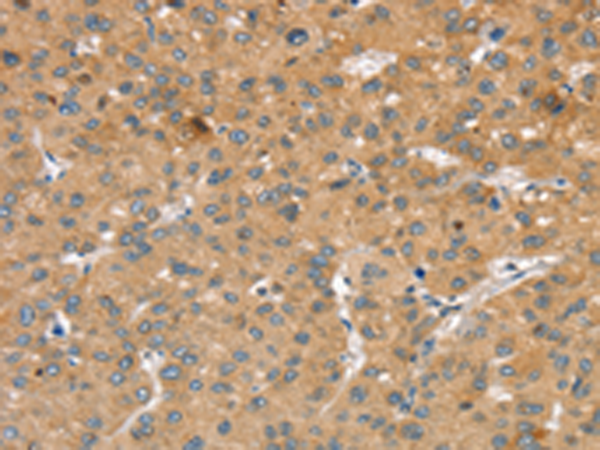


| WB | 咨询技术 | Human,Mouse,Rat |
| IF | 咨询技术 | Human,Mouse,Rat |
| IHC | 1/25-1/100 | Human,Mouse,Rat |
| ICC | 技术咨询 | Human,Mouse,Rat |
| FCM | 咨询技术 | Human,Mouse,Rat |
| Elisa | 1/1000-1/2000 | Human,Mouse,Rat |
| Aliases | SLIL3; Slit-2 |
| WB Predicted band size | 170 kDa |
| Host/Isotype | Rabbit IgG |
| Antibody Type | Primary antibody |
| Storage | Store at 4°C short term. Aliquot and store at -20°C long term. Avoid freeze/thaw cycles. |
| Species Reactivity | Human, Mouse, Rat |
| Immunogen | Synthetic peptide of human SLIT2 |
| Formulation | Purified antibody in PBS with 0.05% sodium azide and 50% glycerol. |
+ +
以下是关于SLIT2抗体的3篇代表性文献,简要整理如下:
---
1. **文献名称**:*Slit Proteins Bind Robo Receptors and Have an Evolutionarily Conserved Role in Repulsive Axon Guidance*
**作者**:Wu W, Wong K, Chen J, et al.
**摘要**:该研究首次报道了SLIT2作为Roundabout(Robo)受体的配体,通过体外和体内实验揭示了其在轴突导向中的排斥性信号功能。研究中使用特异性SLIT2抗体验证了其蛋白表达及与Robo受体的相互作用。
---
2. **文献名称**:*Frequent epigenetic inactivation of SLIT2 in human cancer cells*
**作者**:Dallol A, Da Silva NF, Viacava P, et al.
**摘要**:文章揭示了SLIT2在多种癌症(如肺癌、乳腺癌)中因启动子甲基化而表达下调的现象。通过SLIT2抗体进行免疫组化和Western blot分析,证实了肿瘤组织中SLIT2蛋白的缺失及其作为潜在抑癌基因的作用。
---
3. **文献名称**:*Slit2-N/Robo1 Inhibits Tumor Metastasis by Regulating the Tumor Microenvironment*
**作者**:Prasad A, Qamri Z, Wu J, et al.
**摘要**:该研究探讨了SLIT2通过Robo1受体抑制肿瘤转移的机制,包括调节血管生成和免疫细胞浸润。利用SLIT2抗体进行组织染色和功能阻断实验,证明了其通过微环境调控抑制肿瘤进展的功能。
---
**备注**:以上文献均涉及SLIT2抗体的应用(如检测表达、功能验证等),涵盖神经发育、肿瘤抑制及微环境调控等领域。如需具体实验细节,建议通过PubMed或期刊数据库检索原文。
The SLIT2 antibody is a crucial tool in studying the SLIT2 protein, a member of the SLIT family of secreted glycoproteins. SLIT2 is best known for its role as a ligand for Roundabout (ROBO) receptors, mediating axon guidance, neuronal migration, and cell motility during embryonic development. Beyond neurodevelopment, SLIT2-ROBO signaling regulates diverse processes, including angiogenesis, immune cell migration, and cancer progression. In cancer, SLIT2 often acts as a tumor suppressor by inhibiting cell proliferation, invasion, and metastasis, though context-dependent pro-tumorigenic roles have also been reported.
SLIT2 antibodies are widely used in research to detect and quantify SLIT2 expression in tissues or cell lines via techniques like Western blotting, immunohistochemistry, and immunofluorescence. They help elucidate SLIT2's spatial-temporal distribution, interaction partners, and dysregulation in diseases such as cancer, neurological disorders, and cardiovascular conditions. Polyclonal and monoclonal SLIT2 antibodies target specific epitopes, with validation often involving knockout controls or recombinant protein blocking to confirm specificity. Researchers also employ neutralizing SLIT2 antibodies to inhibit its function in vitro or in vivo, exploring therapeutic potential in pathological angiogenesis or metastasis. Challenges include ensuring antibody recognition of processed SLIT2 variants, as the full-length protein undergoes proteolytic cleavage into active N-terminal and C-terminal fragments. Commercial antibodies vary in species reactivity (human, mouse, rat), requiring careful selection based on experimental models. Recent studies highlight SLIT2's involvement in metabolic diseases and tissue repair, expanding the antibody's applications in translational research.
×